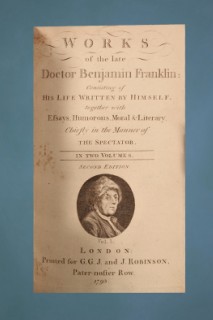The Curious Evolution of Benjamin Franklin's Autobiography
- by Renee Roberts

Works of the late Doctor Benjamin Franklin...in Two Volumes. London: Robinson, 1793
By Renée Magriel Roberts
Many booksellers have personal interests in books that become specialties. I was a comparative literature scholar and teacher before I became a bookseller, so I have always been interested in the content and literary scholarship related to the books in my shop and not just their retail value. An interest -- OK, I admit it -- an obsession -- that has developed over time is Benjamin Franklin, who I find endlessly fascinating. Who else has been more responsible for our language, the can-do American psyche, our values, our major institutions, and the culture and freedom we enjoy? And of course his most famous work is the Autobiography, the most famous American autobiography ever written.
While it is enough in many cases to see the words, "First Edition" on the copyright page, or to recognize the points of issue in a work to determine the first printing, Franklin's Autobiography presents a somewhat steeper learning curve. To understand it, as a scholar or a bookseller, requires understanding its very curious evolution and its changing content and titles. Without studying the Autobiography's publication history, well beyond its first appearance in print, it is difficult to even understand the material and aesthetic value, as well as the accuracy and importance of any iteration at hand.
Unlike works in which the author has supervised publication, Franklin's work is problematic because it was unfinished, published posthumously, published in unauthorized versions, and published in various stages of incompleteness. Moreover its earliest editions went through a translation and retranslation process which did not add to textual accuracy.
It is a work now known to exist in four parts: Part One is directly addressed to William, Franklin's son, in 1771 and written at Twyford, England. Franklin sets the work aside and picks it up again in early 1784, in Passy, France, after receiving some encouraging letters to continue the work (Part Two). Again, the work is set aside until 1788, where Part Three is written in Philadelphia. The fourth and last part is written between 1789 and his death on April 17, 1790. The text itself only discusses Franklin's life through 1763.
There is also an outline of the work, written by Franklin. Only a copy of this outline exists with notes and corrections in Franklin's hand. The scope of the outline makes it clear that Franklin intended a more complete work which unfortunately remained unfinished at the time of his death. What follows is a list of the more important editions of the work.